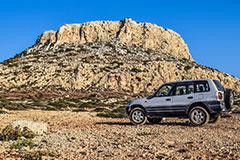How to Drive Better Off-Road - Vol.395
The fun of off-road driving is best understood by those who have experienced it. Leaving the road and hitting the trail is a fantasy that many family car drivers have. Then there are also many of those who own four-by-fours and never dare to leave the road. Knowing some basic things about off-road driving can inspire you to go off-road more often as well as improve the experience.

When it comes to driving, the experience you already have is a serious asset. Skillful drivers know how to get the best from the most common, two-wheel drive, low ground clearance, standard tires cars in all road and weather conditions. Taking your car to the beach, driving in snow or rain, and hitting the dirt road all require a certain level of driving knowledge. Taking your car off-road, however, is a very different challenge.
If we put aside the all too obvious disparity in comfort, the main difference between driving off-road and on the road boils down to driving conditions. Hitting the unknown trail means not knowing what lies ahead, so a good preparation is all too important if you want to be ready to tackle whatever obstacle is waiting out there.
Getting Ready for the First Off-Road Drive
For beginners and even more experienced drivers the best advice is to not go off-road driving alone. Having an extra pair of hands is very useful when you are facing a problem in the middle of nowhere. Other than this, the supplies and equipment are all that matters.
A full tank of gas is a must (a spare tank is a good idea too). Here are some of the other basic off-road necessities you'll need:
- a good spare tire and a tire changing set
- communication device (cell phone, radio)
- navigational aid (charts, GPS)
- first aid kit
- a shovel
- plenty of water
In addition, make sure that your car is fully operational and that you are familiar with its capabilities.
Understanding the Terrain
The terrain is perhaps the most important factor in off-road driving. Once you leave the pavement and hit the dirt, you are facing the ground configuration, surface and weather conditions which can differ significantly from track to track. Different terrain characteristics mean different driving conditions and often require a different level of experience.
Off-road driving in dry conditions on a dirt or grass terrain without steep-angle climbs is a perfect choice for beginners and off-road enthusiasts who are looking to take their everyday vehicle for a dirt spin.
Driving over sand is another experience altogether. Your road driving skills are simply not enough here because this terrain dictates a particular behavior for the car and the driver. On sand, the car can fall through or dig in, so maintaining speed is important. Slowing down too much can leave you in a sand-trap and that's not a comfortable situation. Wider, low-pressure tires are a good choice for such terrains.
If you are looking for a spin in the mud, get ready for some towing. This type of off-road track makes towing a part of the action. It is fun but very risky. Regardless of your driving skills and the characteristics of your vehicle, the situation will get out of hands more than few times.
Closing Words
For those looking to go out there and live the off-road experience, there is no such thing as too much advice. But no matter how much you know you will always find yourself facing a new challenge - that is exactly why off-road driving is so exciting.